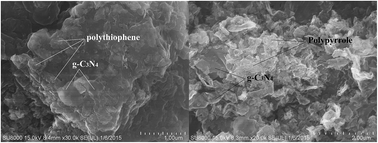Polypyrrole (Ppy) and polythiophene (Ptp) modified g-C3N4 nanocomposites were prepared using a simple sonochemical approach and their photocatalytic performances are compared. XRD, N2 adsorption–desorption, FTIR, UV-Vis, SEM, EIS, XPS and PL are used to characterize the prepared composite materials. The results reveal that no obvious difference is observed in grain size, crystal phase and structural properties between the two series of polymer modified g-C3N4 nanocomposites. The polymer modification can decrease the band gap which is beneficial for visible-light absorption. The introduction of polymers does not act as a visible light sensitizer but facilitates the separation and transport of photogenerated carriers. The visible-light-driven Rhodamine B (RhB) photodegradation performance was carried out to test the catalytic activity of as-prepared g-C3N4 based nanocomposites. Compared with Ppy, a stronger interaction exists between Ptp and g-C3N4 which causes a higher electron–hole separation rate, and thus shows better photocatalytic activity and stability.

